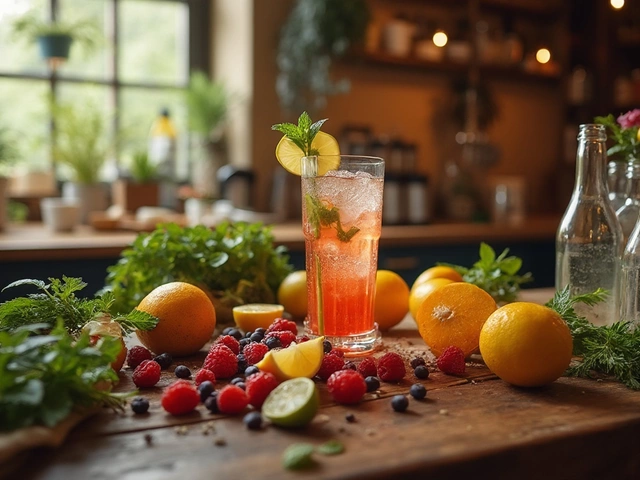Ever thought about how much beer you can actually make with a home brew kit? It's more than just pouring, mixing, and hoping for the best. Most standard kits will set you up with around 5 gallons of home-brewed goodness, which translates to about 40-50 bottles of beer. That's packing your fridge for quite a few game nights!
The size of your kit does matter, though. There are smaller kits for those just getting their feet wet in the brewing world, making around 1 to 2 gallons. Then there are the larger kits for the more ambitious, with yields going up to 10 gallons or more.
Before you run to grab a kit, consider what kind of beer you love and how much you really want. Maybe start small if it's your first rodeo—after all, nobody wants 50 bottles of a beer they don't love!
- Introduction to Home Brew Kits
- Typical Beer Yield
- Factors Affecting Yield
- Choosing the Right Kit
- Brewing Tips for Better Beer
- Conclusion: Embrace Your Inner Brewer
Introduction to Home Brew Kits
Stepping into the world of home brewing can seem like a big leap, but home brew kits make it super accessible. Whether you're a complete newbie or someone wanting to refine their skills, there's a kit designed just for you.
These kits come in all shapes and sizes, designed to cater to various levels of expertise and thirst. At their core, most kits include a fermenter, ingredients like malt extract and hops, and step-by-step instructions to get you brewing in no time. Some even throw in bottles or a bottling bucket, so you’re all set when your beer brewing is done.
Different Types of Kits
There are generally three types to consider:
- Beginner Kits: These are perfect to start with. They usually produce around 1 to 3 gallons, offering just enough beer to learn the ropes without heartbreak if things go south.
- Intermediate Kits: For those with some experience, these kits often yield about 5 gallons. They might include more advanced ingredients and equipment, allowing for greater customization.
- Advanced Kits: These are for serious brewers who want full control over the process. You'll encounter a range of exotic ingredients and might need extra equipment like a wort chiller.
An interesting stat reveals that over 1.2 million Americans dabble in home brewing, with many starting with these kits. It's a hobby that's really brewing up a storm!
Choosing Your First Kit
For those teetering on the edge of trying it, it’s crucial to evaluate your commitment level and budget. Start small if you're testing the waters. It's easier on the wallet and less overwhelming. Remember, the goal is to craft something delicious and pick up a fun new skill.
So, if you're eager to have some fun and enjoy the fruits of your labor, a home brew kit might just be your next best purchase. It's not just about the beer. It's about the whole experience!
Typical Beer Yield
When it comes to brewing your own beer with a home brew kit, knowing how much beer you'll get is key. Most of these kits are designed to brew about 5 gallons or around 18.9 liters of beer. That's roughly equivalent to 40-50 bottles, depending on your bottle size!
Understanding Different Kit Sizes
There are several home brewing kit sizes out there. The most common is the 5-gallon option, which is standard for many beginners and intermediate brewers. But if you're just trying out, smaller 1-gallon kits are perfect for a test run, allowing you to produce 10-12 bottles. On the flip side, there are larger kits brewing up to 10 gallons, ideal for those who want to share their brew with friends and family.
Factors That Affect Your Yield
Several factors can impact how much beer your kit will actually produce. Ingredients used, brewing efficiency, and even evaporation rate during the boil can alter your final yield. Ingredients come with varying levels of fermentables, so the more sugars, the more beer you can end up with!
- Ingredient Quantity: More malt extract can mean a higher yield.
- Brewing Efficiency: A measure of how well your grains convert to sugars during the mash. Higher efficiency gives you more beer.
- Evaporation Rate: If you boil for too long, you lose volume. An hour is generally enough for boiling.
Popular Kit Yields
Here's a quick table showing some typical yields based on kit size options:
| Kit Size | Batch Yield |
|---|---|
| 1 Gallon | 10-12 Bottles |
| 5 Gallons | 40-50 Bottles |
| 10 Gallons | 80-100 Bottles |
Knowing these details helps you plan and make the most out of your brewing sessions. Cheers to more home-brewed adventures!
Factors Affecting Yield
So you've got a home brew kit and you're all set to make your own beer. But hold on, because there are quite a few things that can mess with how much beer you'll actually end up with. It's not always a straightforward shot from kit to a fridge full of bottles.
Kit Quality and Ingredients
First up, let's talk about the kit itself. The quality of your home brew kit can make a big difference. Higher-quality kits often come with better materials and ingredients, leading to a more efficient fermentation process. Look for kits with fresh ingredients, as old or stale elements can affect how much you end up brewing.
Temperature Control
Temperature plays a critical role in brewing. If it's too hot during fermentation, you'll lose some beer to evaporation, and if it's too cold, the yeast might not work effectively. Keep that brew at a steady, optimal temperature for the best results.
Fermentation Process
The yeast needs time to do its job, which means the fermentation period is crucial. Cutting corners might leave you with less beer that tastes a bit off. Not to mention, opening the fermenter too often can let in contaminants that reduce yield.
Brewing Method
There are several brewing methods, like all-grain or extract brewing. Each method has its own impact on yield. For beginners, extract brewing usually results in a higher yield because it's less prone to mistakes compared to all-grain brewing.
Equipment Loss
Dreaded but true, some beer will be lost to hoses, containers, and other equipment. This is called "trub loss." During the brewing process, sediments like hops and grains will settle at the bottom, taking some good beer down with them.
| Factor | Potential Impact on Yield |
|---|---|
| Temperature Control | Up to 10% loss |
| Fermentation Period | 5-8% variation in yield |
| Equipment Loss | 1-3% of total beer volume |
Keeping these factors in check will help you make the most out of your home brewing adventure. The more attention you pay to these details, the better chance you'll have of filling up those bottles to the brim!

Choosing the Right Kit
So, you're ready to start home brewing, but standing in front of a wall of options can be a bit overwhelming. Let's break it down to simplify the process and make it easier to pick the perfect home brew kit for your needs.
Size Matters
The first thing you'll want to consider is how much beer you want to produce. If you’re just starting, a smaller kit that creates 1-2 gallons might be a good choice. It’s less intimidating and you won’t have dozens of bottles to deal with if your first batch doesn’t turn out as expected.
On the other hand, if you’ve got some experience or are confident in your brewing skills, going for the standard 5-gallon size is a great choice. It hits the sweet spot—big enough to share, but not overwhelming.
Kit Components
Almost all kits will have the basics—ingredients like malt extract, hops, and yeast. But some might come with extras. Check if the kit includes all the necessary tools like a fermentation bucket, airlock, and siphon. If not, you’ll need to grab a few additional items to get the brew going smoothly.
Types of Beer
Your beer preference can guide your kit choice. Kits often come with specific beer styles—ales, stouts, lagers. Know what beer tickles your taste buds and pick accordingly. Wouldn't want 40 bottles of a beer you're not a fan of, right?
Stat Perspective
According to recent data, most entry-level kits priced around $50-$100 can yield nearly $200 worth of beer compared to retail prices. Choosing the right kit can save you a ton in the long run!
Remember, the best kit for you is one that fits your brewing goals and your space. Start small if you’re unsure, and you can always scale up. Happy brewing!
Brewing Tips for Better Beer
Getting into the groove of home brewing might sound tricky at first, but with these tips, your home brew kit will soon become one of your favorite gadgets. Let’s make sure your next batch of beer is your best yet!
Start with Fresh Ingredients
Your beer is only as good as your ingredients. Always choose fresh, high-quality hops, malt, and yeast. Stale ingredients can lead to off-flavors, and nobody wants that in their beer.
Sanitize Like a Pro
This might sound boring, but sanitizing is crucial. Make sure your equipment is spotless to prevent unwanted bacteria. A tiny bit of unwanted bacteria can ruin your batch.
Master Your Fermentation
Keeping a consistent temperature during fermentation is key. Too hot, and you might develop unwanted flavors. Too cold, and the yeast might not work efficiently. Try to keep it in the range recommended for your yeast type.
| Temperature Range | Effect on Beer |
|---|---|
| 59-68°F (15-20°C) | Ideal for ales |
| 45-55°F (7-13°C) | Perfect for lagers |
Patience is a Virtue
Rushing the process is a rookie mistake. Let your home brew kit do its job. Give it time to ferment fully, even if you’re eager to taste your creation. Good things come to those who wait.
Taste and Take Notes
Every batch can teach you something new. Jot down what you taste in each sip; this will help you tweak recipes and improve over time. Think of it like your brewing diary.
- Flavor Profiles - Identify if it's malty, hoppy, or something else.
- Aftertaste - Is there a lingering flavor?
- Suggestions - What would you change next time?
With these tips in mind, grab your home brewing kit and dive into your next brewing adventure. The more you practice, the better your creations will become!
Conclusion: Embrace Your Inner Brewer
So you've made it this far into the home brewing journey. Whether you're just starting out or already a seasoned pro, home brewing is an exciting hobby that delivers tons of satisfaction—especially when pouring that first perfect pint of your own beer.
Celebrate the Brew
The best part of using a home brew kit is that it allows you to create beer variations you won't find in any store. By tweaking recipes or ingredients, you get to experiment and find that unique taste you love. Remember, practice makes better. The more you brew, the more you'll understand your preferences and what makes your beer special.
Too Much or Just Enough?
When starting out, it’s easy to get excited and end up with a refrigerator full of one type of beer. Think about both your space and how quickly you'll drink it. If you're a frequent host or love giving gifts, 5 gallons won’t last as long as you think! But if you brew slowly, consider a smaller home brew kit.
Stay Updated with Brewing Trends
The world of beer is ever-evolving. New flavors and trendy brewing techniques pop up regularly. Keep an eye on these movements, join local brewing groups or online forums, and learn from others who've been brewing longer than you.
| Kit Size | Approximate Bottles |
|---|---|
| 1 Gallon | 8-10 |
| 5 Gallons | 40-50 |
| 10 Gallons | 80-100 |
By embracing your inner brewer, you're not only creating something you enjoy, but you're also joining a community passionate about craft and quality. Cheers to your brewing adventure!


